By Mahboob Shah Mahboob

ABSTRACT
Afghanistan is rich in natural resources, including water resources, gas and crude oil, gemstones, and other minerals, which together make up a sizable portion of the country’s national wealth. Despite this, 49.4% of Afghans live in poverty, and the government is unable to properly manage the country’s natural resources because of security issues and concerns about neighbouring countries. In particular, the gemstones found in Badakhshan Province and other unstable areas of the country serve as a the broad knowledge regarding natural resources and their status in Afghanistan is the study’s goal. According to studies, the following issues provide the greatest current problems to Afghanistan’s water resources. A severe scarcity of drinking water impacts every resident in the river basin of Kabul. Afghanistan’s civil war, which started in late 1978, has lasted for 2.5 decades and has severely damaged the nation’s ecosystem and water resources. Since the conflict is done, one of the most crucial responsibilities facing Afghanistan’s government is managing its water resources to supply water. A lack of clean drinking water. As to the DACAAR-conducted groundwater survey, both natural hydrochemical processes and human activities have contributed to the steadily declining quality of groundwater. One example of how climate change is causing variations in natural catastrophes is the occurrence of floods and droughts, which Afghanistan has traditionally experienced. The groundwater level is dropping daily due to a lack of awareness on how people use groundwater storage and to fast population growth.
Keywords: Afghanistan, Natural Resource, Poverty, Governance
* Corresponding Author
1 INTRODUCTION
Afghanistan’s land area is around 652000 square kilometres, and its latitudes are between 33.9N and 32.4N and its longitudes are between 67.7E and 53.6E. To the north of Afghanistan are Tajikistan, Uzbekistan, and Turkmenistan; to the west are Iran; to the east are Pakistan; and to the northeast is China figure 1.
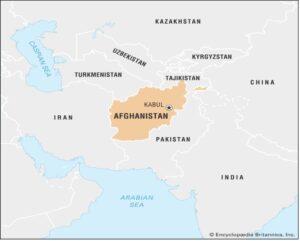
Figure 1: Afghanistan’s place on the global map.
Due to its near-mountainous terrain, Afghanistan has abundant natural water resources in its rivers. Afghanistan’s western and south-western regions get a large number of streams that originate in the country’s north and centre. The majority of the water resources are provided by Hindukush Mountain. Afghanistan is home to around 25 large streams, some of which are listed here. These streams meander through numerous provinces among vast deserts before draining into neighbouring nations. According to estimates, the nation’s total yearly potential water resource is 75 billion cubic metres, of which 57 billion are surface waters and the remaining 18 billion are ground waters Afghanistan is situated in a subtropical latitude range, with a topography that results in a remarkably diverse climate. Areas north of high mountains experience a dry or continental environment, while areas south of the mountains experience a less continental climate. In July, the average temperature is +32ºC, whereas in January it is -2ºC. The highest recorded temperature in the deserts (Dasht-e Margo) is +50ºC, and the lowest recorded temperature in the Hindukush mountains is -50ºC. In Afghanistan, the yearly evapotranspiration is relatively low. The precipitation fluctuates due to low temperatures, ranging from 900 mm to 1200 mm near the Hindukush Mountain to 1800 mm in the southern and southwestern parts.
Afghanistan’s economy is dominated by the agricultural sector. About two thirds of the nation’s income comes from it. Afghanistan’s government has made the development of the water sector one of its top goals, but the nation lacks the technical, institutional, and management capacity as well as the competent people resources needed to achieve this goal. But the nation faces a number of water-related issues, including starvation, drought, and environmental damage from over-exploitation of aquifers.
Over eighty percent of Afghans rely only on natural resources to meet their daily requirements. Many Afghan proverbs highlight the importance of water as a natural resource, and as such, effective water management is critical to the nation’s future prosperity. Afghanistan is already badly endangered by a lack of experience, funds, and management for water resources, as well as by the country’s increasing urbanization and socioeconomic development, especially in its many urban centres.
1.1 An Overview of the Natural Resources of Afghanistan
Natural resources are rich and diverse in Afghanistan, and they have historically shaped the nation’s social structures and economic environment. These resources are diverse and include minerals, jewels, gas, water, and crude oil. Afghanistan’s geological makeup has bestowed upon it an abundance of these resources, so augmenting its prospects for economic growth.
1. Mineral Wealth:
Rare earth elements, copper, gold, iron ore, and lithium are just a few of the abundant mineral resources in Afghanistan. These resources could spur industrial development and bring in a sizable amount of money for the nation.
2. Water Resources:
With a large number of rivers and groundwater reserves, the nation has an abundance of water resources. These water sources are vital to agriculture because they sustain animals and crops and help rural populations maintain their way of life.
3. Gas and Crude Oil:
If handled well, Afghanistan’s substantial deposits of natural gas and crude oil might improve energy security and lessen reliance on outside sources.
1.2 The Significance of Land and Water Resources:
- Agricultural Sustenance:
The agricultural industry, which is the main engine of Afghanistan’s economy, depends heavily on land and water resources. The cultivation of crops that provide the populace with staple foods is made possible by these resources.
- Livelihoods of Rural Communities:
Communities in rural areas, where a sizable section of the population lives, mainly depend on agriculture. Arable land and water must be available for farming in order to produce food and revenue.
- Development of the Economy:
Water resources, especially rivers and groundwater, are essential for many economic activities, such as hydropower production, industrial processes, and agricultural irrigation. Development and economic diversification are facilitated by efficient land use.
1.3 Research Objectives
- The study’s main goal is to give readers a thorough understanding of Afghanistan’s natural resource situation.
- The environment and water resources of Afghanistan have suffered greatly as a result of the country’s 2.5-decade-long civil conflict.
- The most pressing issue related to water resources in the Kabul river basin is the acute lack of potable water, which affects all inhabitants.
2 LITERATURE REVIEW
Ali and others (2022) It are likely that the study investigates the complex relationship between biodiversity and land use changes in Pakistan’s District Kurram. A thorough examination of the literature might go into detail about the effects that land use changes have on ecosystems and the supply of vital services. It might also look into how these impacts are measured.
Bose and associates (2023) The relationship between ecosystem services and initiatives to promote peace in war areas, particularly Afghanistan, may be the subject of this article’s literature review. In order to identify policy gaps and evaluate the security implications of these gaps, it could examine current frameworks that integrate ecological, sustainable development, and peace.
Dost and Kasiviswanathan (2023) The assessment of drought risk for river basins in Afghanistan and other contexts including the estimation of the sustainability of water resources is probably covered by the literature review. It might examine current methods for reducing the effects of drought and techniques for evaluating the sustainability of water resources.
Hamidov & Associates (2022) The interdisciplinary approaches to studying the water-energy-food nexus are anticipated to be examined in the literature review for this study. With an emphasis on Central Asia, it might examine how comparable research has been operationalized in social-ecological systems. Research that already exists in this area on sustainable development may be a major area of interest.
Ibrahimi and Haziq (2022) One possible focus for the literature evaluation would be GIS applications in rainwater harvesting site selection. It might look at the body of research on GIS approaches for finding appropriate locations around the world and evaluate how well they work in the unique circumstances of Afghanistan’s Kandahar Province.
Hussainzada and Lee (2022) It is probable that research on enhanced agricultural irrigation systems in arid areas will be included in the study of the literature. With an emphasis on the use of the Soil and Water Assessment Tool (SWAT) in comparable situations, it might examine how hydraulic structures affect crop production.
3 PROPOSED METHODOLOGY
3.1 Study Area
Afghanistan is a landlocked nation that lies in the middle of Asia. As seen in Fig. 1, it shares borders with China, Pakistan, Iran, Turkmenistan, Uzbekistan, Tajikistan, and the North, East, and West, respectively. This nation spans 652,000 square km. Afghanistan has a dry continental climate and is a mountainous nation. The range of temperature variation is -10 °C in the winter to 45 °C in the summer.
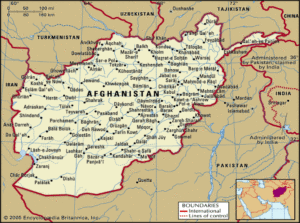
Figure2: Afghanistan Location
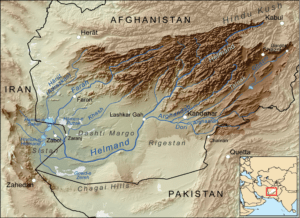
Figure 2: Map of the river basins in Afghanistan
Table 1: Map of the river basin in Afghanistan
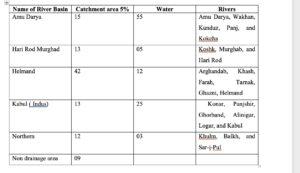
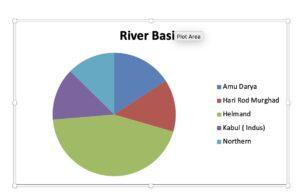
Figure1: Map of the river basin
Table 2: Basic characteristics of Afghanistan’s six climate zones
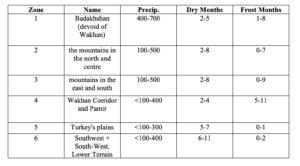
Table 3: Prec, temp, and ETP collected data annually
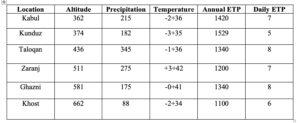
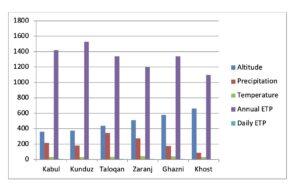
Figure2: Prec, temp, and ETP collected data annually
The majority of Afghanistan’s arable land is irrigated by rainfall because of the country’s northwest’s low temperatures, which cause rivers to carry water. The lush irrigation plains of Afghanistan correspond with the forested terrain in the east. In the southern portion of Afghanistan, double harvests are being sown due to the extended growing season. The majority of Afghanistan’s dessert region is in the country’s north and south, where there is less vegetation because there aren’t as many water supplies. With regard to water resources, Afghanistan is among the richest nations; these resources originate from rainfall in its highlands. The melting of snow in Hindu Kush provides the nation with more than 80% of its water. The total annual renewable water resource was recently estimated to be 75 billion cubic metres, of which 57 billion are surface waters and 18 billion are groundwater.
Table 4: Water resource in Afghanistan

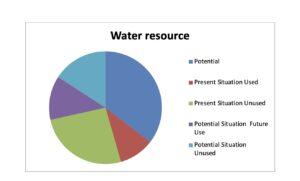
Figure3: Water resource in Afghanistan
3.2 Data Collection
- Rainfall Patterns:
Acquire historical rainfall data using remote sensing, on-site observations, and meteorological agencies to examine irregular and timely distribution patterns. Use GIS to conduct spatial analysis.
- Water Resource Management:
Compile information about the infrastructure, regulations, and procedures used currently for the management of water resources. Interview the appropriate authorities and organisations that are involved in water governance.
- Hydraulic Structures:
Examine the capacity, efficiency, and state of the hydraulic structures that are currently in place in the river basins for the purpose of storing water. Evaluate how well they will mitigate the water scarcity.
- Groundwater Quality:
Analyse groundwater quality using information from DACAAR’s groundwater survey. Examine how groundwater quality is affected by both human activity and natural hydrochemical processes.
- Climate Change Impacts:
To evaluate changes in temperature, precipitation, and extreme weather occurrences, compile climate data. Examine the relationship between droughts and floods and other natural disasters and the components of climate change.
- Population Growth and Groundwater Usage:
Gather demographic information to comprehend trends in population increase. To gauge public awareness of groundwater storage utilization and its effects on groundwater levels, conduct surveys and interviews
- War Impact:
Examine past information, records, and speak with people to find out how the 25-year civil war has affected development, sustainability, conservation, and water resources.
- Potable Water Scarcity in Kabul River Basin:
Pay attention to how severely the Kabul river basin is lacking in drinkable water. Compile information on water availability, quality, and the socioeconomic effects of the scarcity on the locals.
3.3 Data Analysis
Apply statistical methods, GIS, and modeling techniques to analyze the collected data. Examine correlations between rainfall patterns, water resource management, hydraulic structures, groundwater quality, climate change impacts, population growth, and the consequences of the civil conflict on water resources.
- Statistical Methods:
- Rainfall Patterns: To find trends, variances, and seasonal patterns in historical rainfall data, use time-series analysis.
To quantify and comprehend the rainfall distribution, use statistical tools such as regression analysis, mean, and standard deviation.
- Water Resource Management: To assess efficiency, examine water extraction rates, consumption trends, and reservoir storage capacities over time.
To find relationships between water availability and management techniques, use statistical tests.
- Hydraulic Structures: Evaluate the efficacy of hydraulic structures through statistical comparisons of their effects on water availability, storage capacity, and water release rates.
- Groundwater Quality: To find trends or anomalies in groundwater quality, analyse DACAAR’s groundwater survey data using statistical techniques.
- Impacts of Climate Change: To find trends in temperature, precipitation, and extreme weather occurrences, run statistical tests on climate data.
- Population Growth: To determine patterns in population growth, do statistical analysis on demographic data.
- Consequences of Civil Conflict: Employ statistical techniques to examine past data in order to identify patterns and connections with water resources.
- Analysis using Geographic Information Systems (GIS):
- Rainfall Patterns
To identify locations with consistently uneven or insufficient rainfall, use GIS to map the spatial distribution of historical rainfall patterns.
- Water Resource Management
Use geographic information systems (GIS) to map the locations of water management infrastructure and overlay it with other datasets to determine how close water sources are.
- Hydraulic Structures
Use GIS to map the locations and states of hydraulic structures and evaluate how well they mitigate water scarcity.
- Groundwater Quality
Draw spatial depictions of the criteria governing groundwater quality and superimpose geological and human-made features on top of them.
- Climate Change Impacts
To find connections, use GIS to build spatial representations of the impacts of climate change and overlay them with other datasets.
- Population increase
Create a spatial map of population increase and evaluate how it relates to patterns of water supply and use.
- Repercussions of Civil Conflicts
To evaluate the long-term effects, use GIS to map the areas affected by conflicts and overlay the data on water resources.
- Modelling Methods:
Create mathematical models that incorporate variables including rainfall patterns, water management techniques, hydraulic structures, groundwater quality, climate change impacts, population increase, and the aftermath of civil unrest in order to simulate various scenarios involving the availability of water under various conditions.
- Water quality
Unfortunately, around 70 % population of urban areas and as well as 80% population of rural areas does not access to drinking water in Afghanistan. Most people are suffering from the shortage of water for domestic use in Afghanistan
With accordance the result of the Afghanistan Geological Survey group which samples of water-quality are collected in 8 surface-water sites, and 92 groundwater, spring, and karez sites in the Kabul Basin shown that both surface water and groundwater are detected by bacterial contamination
According to drying the wells safe portable water is a severe problem in Afghanistan, people digging their wells and drying process is ongoing; therefore, they keep Deeping
- Civil War in Afghanistan
Over a quarter of a million people died and one million were injured during the 25-year civil war in Afghanistan. Three million more fled the country and settled abroad. A 1997 estimate by FAO/UNDP on the effects of the country’s instability and civil war, 443, revealed that just thirty percent of the 3.4 million hectares of fertile land could be used for cultivation.
The Soviet Union invaded Afghanistan in 1979, and it left the country in 1991 following a bloody conflict. It has also had an impact on the political, economic, environmental, and social systems. Destroying street trees in Kabul and Parwan is one of the best instances, as it has a direct impact on the environment. Numerous hydraulic constructions built for irrigation on Afghanistan’s rivers during the conflict destroyed and damaged every metrological station.
CONCLUSION
Afghanistan is ideally situated at the intersection of important commercial routes in Asia, making it an ideal path for the effective movement of supplies and troops from the west to the east. In addition to its strategic location, Afghanistan has a wealth of natural resources that could make it one of the most resource-rich countries in the world in the future. This wealth of resources offers a significant chance for the creation of numerous work opportunities in addition to holding immediate promise for combating poverty.
There’s promise for Afghanistan’s long-term peace and stability in the continuous exploration and exploitation of its water resources and in the critical investments made in the country’s rapidly growing mining sector. Afghanistan can steer towards economic development and create the foundation for a more robust and self-sustaining future by utilising the potential present in these natural resources. Fundamentally, the combination of wealth in resources and advantageous location creates opportunities for diverse growth and development, offering Afghanistan a narrative that is revolutionary in terms of both its economy and society.
RECOMMENDATION
- Integrated Resource Management:
Create and put into action comprehensive plans for the long-term, sustainable management of Afghanistan’s natural resources, making sure to take into account both long-term economic gains and environmental preservation.
- Increasing Capacity:
Investing in educational and vocational training programmes can help build the capacity of the local workforce and produce a trained labour pool that can support the sustainable use of natural resources.
- Infrastructure Development:
Give infrastructure development top priority, especially in the mining industry, to enable the responsible and effective extraction of resources. Investing in processing facilities, transportation networks, and contemporary mining technology are all part of this.
- Engagement of Stakeholders:
To guarantee that resource development initiatives are in line with the requirements and goals of the populace, encourage cooperation between the government, local communities, and private businesses. Participate in open, inclusive decision-making procedures.
- Preservation of the Environment:
In order to reduce the negative effects on ecosystems, resource extraction activities should adhere to strict environmental protection regulations. Implement best practices to reduce environmental deterioration and advance sustainable development.
Mahboob Shah Mahboob is Research Scholar of Faculty of Management, Vivakananda Global University, Jaipur
Dr. Vijayendra Kumar Shrivastava is Associate Professor of Department of Management Studies, Vivakananda Global University, Jaipur
REFERENCES
- Ali, M., Yar, P., Khan, S., Muhammad, S., Hussain, W., Hussain, K., … & Bussmann, R. W. (2022). Land use and land cover modification and its impact on biodiversity and the ecosystem services in District Kurram, Pakistan. Boletín Latinoamericano y del Caribe de Plantas Medicinales y Aromáticas, 21(3).
- Bose, S., Mancino, M., & Simangan, D. (2023). Ecosystem services and sustainable peace in Afghanistan: Gaps in national policy and its security implications. Global Policy.
- Dost, R., & Kasiviswanathan, K. S. (2023). Quantification of Water Resource Sustainability in Response to Drought Risk Assessment for Afghanistan River Basins. Natural Resources Research, 32(1), 235-256.
- Hamidov, A., Daedlow, K., Webber, H., Hussein, H., Abdurahmanov, I., Dolidudko, A., … & Helming, K. (2022). Operationalizing water-energy-food nexus research for sustainable development in social-ecological systems: An interdisciplinary learning case in Central Asia. Ecology and Society, 27(1).
- Haziq, M. A., & Ibrahimi, A. R. (2022). Identification of Suitable Sites for Rainwater Harvesting Using GIS in Kandahar Province, Afghanistan. Indian Journal of Science and Technology, 15(47), 2646-2661.
- Hussainzada, W., & Lee, H. S. (2022). Effect of an improved agricultural irrigation scheme with a hydraulic structure for crop cultivation in arid northern Afghanistan using the Soil and Water Assessment Tool (SWAT). Scientific Reports, 12(1), 5186.
- Hussainzada, W., Cabrera, J. S., Samim, A. T., & Lee, H. S. (2023). Water resource management for improved crop cultivation and productivity with hydraulic engineering solution in arid northern Afghanistan. Applied Water Science, 13(2), 41.
- Johnson, M. F. (2022). Local engagement in environmental peacebuilding: protected area development as a pathway to peace in Afghanistan. Development in Practice, 32(6), 755-767.
- Khan, M. Z., Ali, N., & Margerum, R. D. (2022). Community-based and traditional natural resource conservation in Northern Pakistan: comparative analysis of attitudes and beliefs. Journal of Environmental Planning and Management, 65(14), 2657-2675.
- Khurram, S., Larawai, M. I., Shalizi, M. N., Akamani, K., & Groninger, J. W. (2023). Assessing regeneration strategies for sustaining intensively used chilgoza pine-dominated community forests in Afghanistan. Trees, Forests and People, 14, 100443.
- Khurram, S., Shalizi, M. N., Bashari, M., Akamani, K., & Groninger, J. W. (2023). Barriers and opportunities regarding community-based forest management in Afghanistan: considerations for fragile states. Environmental Conservation, 1-11.
- Najmuddin, O., Li, Z., Khan, R., & Zhuang, W. (2022). Valuation of Land-Use/Land-Cover-Based Ecosystem Services in Afghanistan—An Assessment of the Past and Future. Land, 11(11), 1906.
- Najmuddin, O., Qamer, F. M., Gul, H., Zhuang, W., & Zhang, F. (2021). Cropland use preferences under land, water and labour constraints—Implications for wheat self-sufficiency in the Kabul River basin, Afghanistan. Food Security, 13, 955-979.
- Ochungo, P., Khalaf, N., Merlo, S., Beldados, A., M’Mbogori, F. N., Tiki, W., & Lane, P. J. (2022). Remote sensing for biocultural heritage preservation in an African semi-arid region: A case study of indigenous wells in northern Kenya and Southern Ethiopia. Remote Sensing, 14(2), 314.
- Pathak, S. R., Shrestha Pradhan, N., Guragai, S., Baksi, B., Azizi, F., & Shrestha, A. B. (2022). Complexities and Opportunities of Multi-Stakeholder Partnerships: A Case Study of Water Resource Management in Afghanistan. Sustainability, 14(23), 15496.
- Patyal, S. (2022). RUSLE-based soil erosion assessment and erosion control evaluation in the Kabul Watershed. Cent Asian J Water Res, 8(1), 143-159.
- Shams, A. K., & Muhammad, N. S. (2022). Toward sustainable water resources management: critical assessment on the implementation of integrated water resources management and water–energy–food nexus in Afghanistan. Water Policy, 24(1), 1-18.
- Sherzad, S., & Chennappa, T. N. (2022). Sustainability for the Watershed Management in Afghanistan: Example from Amu River Basin.
- Yousafzai, S., Saeed, R., Rahman, G., & Farish, S. (2022). Spatio-temporal assessment of land use dynamics and urbanization: linking with environmental aspects and DPSIR framework approach. Environmental Science and Pollution Research, 29(54), 81337-81350.
- Zaryab, A., Nassery, H. R., & Alijani, F. (2022). The effects of urbanization on the groundwater system of the Kabul shallow aquifers, Afghanistan. Hydrogeology Journal, 30(2), 429-443.




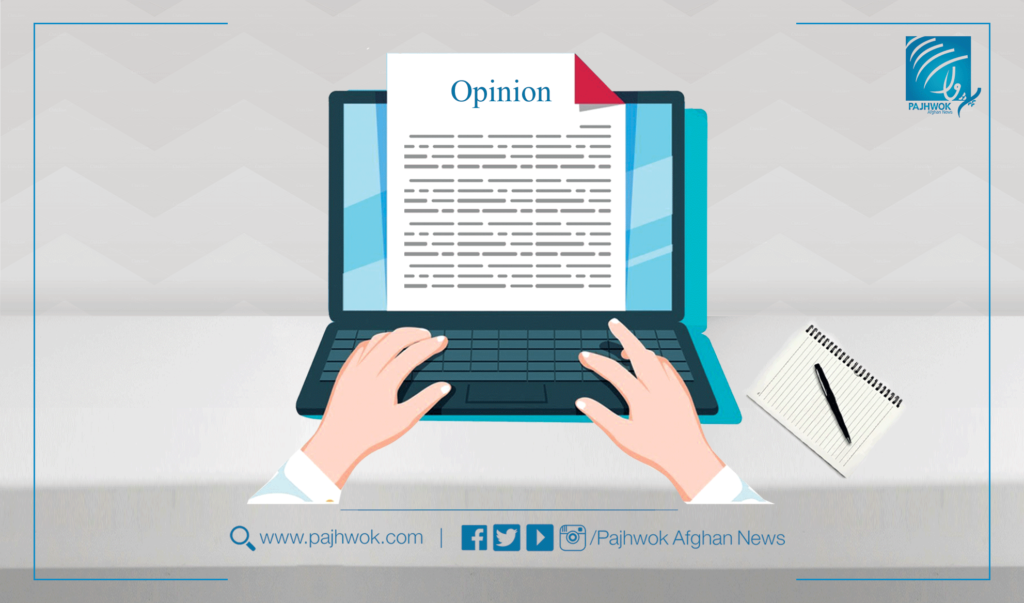


GET IN TOUCH
NEWSLETTER
SUGGEST A STORY
PAJHWOK MOBILE APP